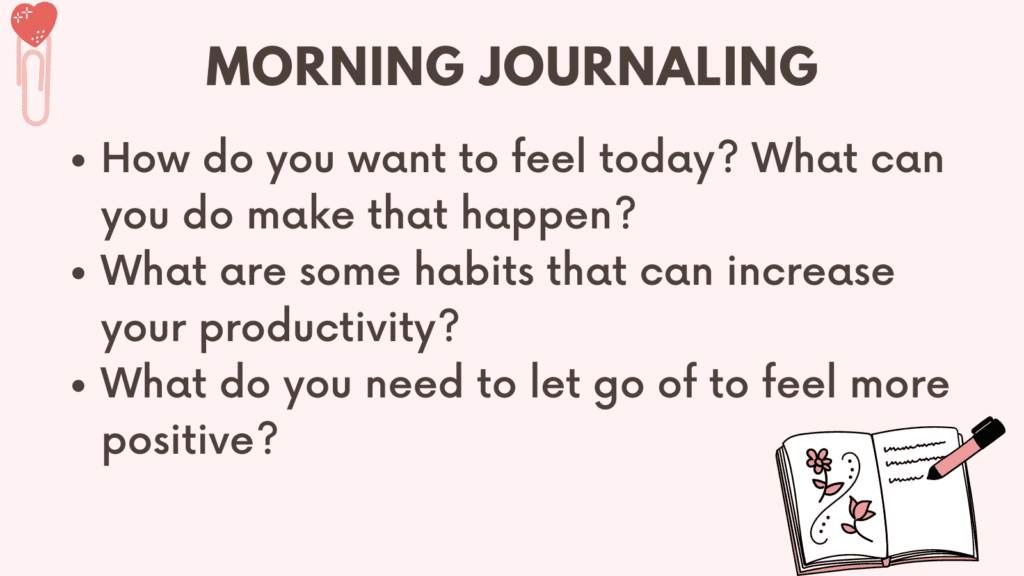What Are Emotional Writing Prompts?
Emotional writing prompts are prompts designed to evoke specific emotions and help individuals tap into their feelings.
These prompts can be used for creative writing, journaling, or personal reflection.
Emotional writing prompts can range from happy and uplifting prompts to more difficult and challenging prompts that encourage individuals to explore complex emotions like grief, anger, or heartbreak.
he goal of emotional writing prompts is to help individuals connect with their emotions and use that connection to create honest, meaningful writing.
Benefits Of Journaling
- Builds emotional resilience
- Improves your sleep and overall mental wellness
- Encourages positivity and mindfulness
- Provides self-awareness and reflection
- Provides clarity of thoughts and feelings
- Reduces stress and anxiety
Related: Top +100 Journal Prompts For Mental Health [+Free PDF Printable!
Emotional Writing Prompts To Process Emotions
1. How do you feel about yourself today, at this moment?
2. What has been bothering you the most lately?
3. What do you have no control over regarding the situation causing you pain?
4. What emotions do you experience most often? Where do you feel them in your body?
5. Which emotions do you find hardest to accept (guilt, anger, disappointment, etc.)?
6. Are there any feelings you’re trying to numb (by keeping yourself busy, using addictions, etc.) because you’re afraid they’re too raw or difficult?
7. Are you willing to uncover the sources of your pain? Why or why not?
8. What has your pain taught you?
9. What are the most important lessons you’ve learned from allowing yourself to feel your painful emotions?
10. What would tell a dear friend who’s struggling with the same emotions?
11. Describe an experience from your past that ultimately made you more resilient.
12. Write down at least 5 affirmations for yourself related to allowing yourself to feel your emotions.
The following are some examples:
- I am allowed to feel this way.
- I am not defined by what I feel.
- I can breathe my way through this.
- I own my emotions so they don’t own me.
13. Make a list of things that bring you joy.
14. What good-feeling thoughts do you want to have?
Related: How To Stop Self-Critical Thoughts Using These Top 10 Techniques
15. Make a list of things that have been helpful cope with difficult emotions in the past?
16. What could you do to boost your mood in a healthy way today?
17. What do you need to do more or less of to improve your well-being?
18. What are you the most grateful for right now?
19. What words do you need to hear spoken to help you feel safe and less alone?
20. Describe your support system including friends, family, and community.
21. What changes do you need to make going forward?
Note: If writing about painful emotions is too distressing, don’t push yourself. Consider seeing a therapist to help you explore and address these feelings.
Psychologist Locator and the National Register are two websites for locating psychologists in USA.
Related: How To Sit With Painful Emotions? (Top 9 Difficult Emotions)

How to Use Emotional Writing Prompts?
1. Choose a prompt that resonates with you: There are many emotions writing prompts available online or in books. Choose one that speaks to you and that you feel comfortable exploring.
2. Set aside time: Find a quiet and comfortable place where you can write without distractions. Set aside some time to reflect on the emotion and write down your thoughts.
3. Reflect on the emotion: Take time to think about the emotion you want to explore. What triggered it? How does it feel? What physical sensations do you experience when you feel this emotion?
4. Write down your thoughts: Use the prompt as a starting point for your writing. Write down your thoughts, feelings, memories, and any insights that come up. Don’t worry about grammar or spelling; just let your thoughts flow.
5. Be honest with yourself: Your journal is a safe place where you can be honest with yourself. Don’t censor your thoughts or feelings; write down everything that comes to mind.
6. Revisit your journal entries: Over time, revisit your journal entries to see how your thoughts and feelings have evolved. This can help you gain insight into your emotions and how to manage them more effectively.
Related: Best 10 Self Discovery Books
Conclusion
Keeping a journal can help you identify what’s causing you stress or anxiety and work on a plan to address them.
However, journaling is just one aspect of a healthy lifestyle. To get the most benefits, you need to eat a healthy diet, exercise regularly, get quality sleep, and make the time to relax and meditate each day.
Remember that emotions journal prompts can be a helpful tool for self-reflection, but they should not replace professional help if you are struggling with intense or overwhelming emotions.
References
- Emotional and physical health benefits of expressive writing | Advances in Psychiatric Treatment | Cambridge Core
- Online Positive Affect Journaling in the Improvement of Mental Distress and Well-Being in General Medical Patients With Elevated Anxiety Symptoms: A Preliminary Randomized Controlled Trial
- Benefits of Journaling for Mental Health (5 Science-Based Benefits of Journaling for Anxiety and Depression)) | Holstee
- The Mental Health Benefits of Journaling | Psych Central
- 83 Benefits of Journaling for Depression, Anxiety, and Stress (positivepsychology.com)
- Journaling isn’t just good for mental health. It might also help your physical health. (nbcnews.com)
- Benefits of Journaling: The Science and Philosophy Behind Keeping a Di – Intelligent Change



